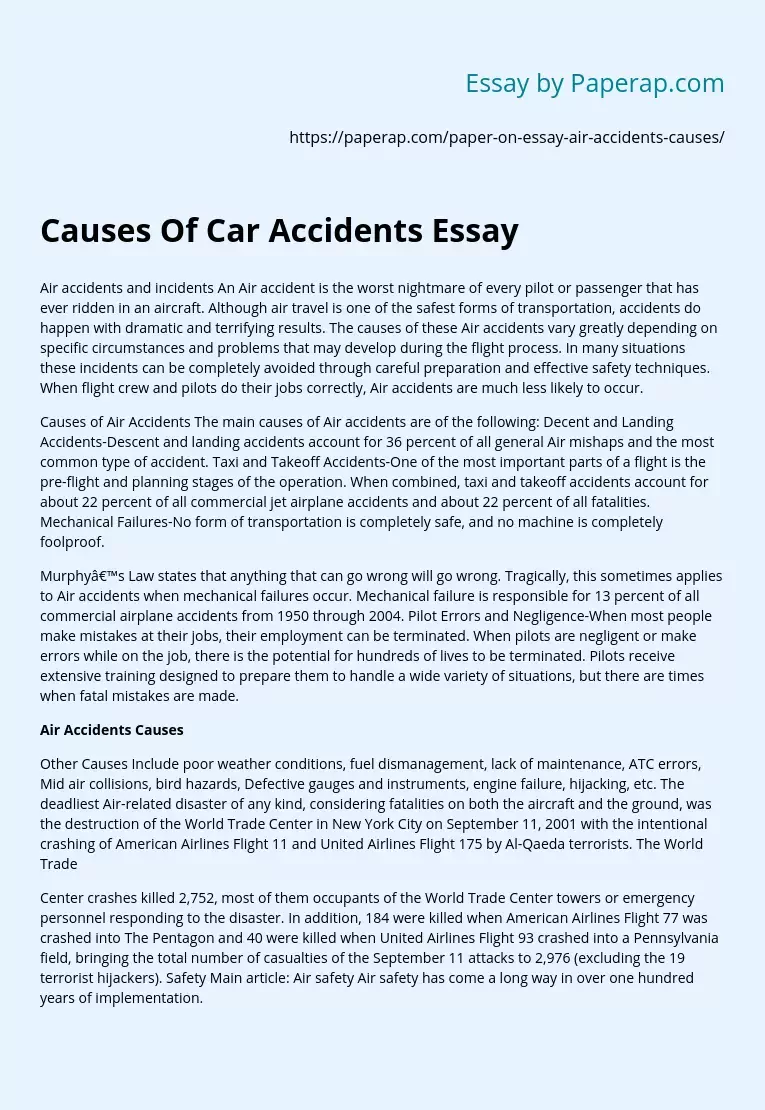Causes Of Car Accidents Essay
Air accidents and incidents An Air accident is the worst nightmare of every pilot or passenger that has ever ridden in an aircraft. Although air travel is one of the safest forms of transportation, accidents do happen with dramatic and terrifying results. The causes of these Air accidents vary greatly depending on specific circumstances and problems that may develop during the flight process. In many situations these incidents can be completely avoided through careful preparation and effective safety techniques. When flight crew and pilots do their jobs correctly, Air accidents are much less likely to occur.
Causes of Air Accidents The main causes of Air accidents are of the following: Decent and Landing Accidents-Descent and landing accidents account for 36 percent of all general Air mishaps and the most common type of accident. Taxi and Takeoff Accidents-One of the most important parts of a flight is the pre-flight and planning stages of the operation. When combined, taxi and takeoff accidents account for about 22 percent of all commercial jet airplane accidents and about 22 percent of all fatalities.
Mechanical Failures-No form of transportation is completely safe, and no machine is completely foolproof.
Murphy’s Law states that anything that can go wrong will go wrong. Tragically, this sometimes applies to Air accidents when mechanical failures occur. Mechanical failure is responsible for 13 percent of all commercial airplane accidents from 1950 through 2004. Pilot Errors and Negligence-When most people make mistakes at their jobs, their employment can be terminated. When pilots are negligent or make errors while on the job, there is the potential for hundreds of lives to be terminated.
Pilots receive extensive training designed to prepare them to handle a wide variety of situations, but there are times when fatal mistakes are made.
Other Causes Include poor weather conditions, fuel dismanagement, lack of maintenance, ATC errors, Mid air collisions, bird hazards, Defective gauges and instruments, engine failure, hijacking, etc. The deadliest Air-related disaster of any kind, considering fatalities on both the aircraft and the ground, was the destruction of the World Trade Center in New York City on September 11, 2001 with the intentional crashing of American Airlines Flight 11 and United Airlines Flight 175 by Al-Qaeda terrorists. The World Trade
Center crashes killed 2,752, most of them occupants of the World Trade Center towers or emergency personnel responding to the disaster. In addition, 184 were killed when American Airlines Flight 77 was crashed into The Pentagon and 40 were killed when United Airlines Flight 93 crashed into a Pennsylvania field, bringing the total number of casualties of the September 11 attacks to 2,976 (excluding the 19 terrorist hijackers). Safety Main article: Air safety Air safety has come a long way in over one hundred years of implementation.
In modern times, two major manufacturers still produce heavy passenger aircraft for the civilian market: Boeing in the United States of America and the European company Airbus. Both have placed huge emphasis on the use of Air safety equipment, now a billion-dollar industry in its own right, and made safety a major selling point—realizing that a poor safety record in the Air industry is a threat to corporate survival. Some major safety devices now required in commercial aircraft involve: Evacuation slides — aid rapid passenger exit from an aircraft in an emergency situation. Advanced avionics – Computerized auto-recovery and alert systems.
Turbine engines – durability and failure containment improvements Landing gear – that can be lowered even after loss of power and hydraulics. Aircraft Crashes Record Office (ACRO) The Geneva-based Aircraft Crashes Record Office (ACRO) compiles statistics on Air accidents of aircraft capable of carrying more than six passengers, not including helicopters, balloons, or fighter airplanes. The ACRO announced that the year 2007 was the safest year in Air since 1963 in terms of number of accidents. [7] There had been 136 accidents registered (compared to 164 in 2006), resulting in a total of 965 deaths. 004 was the year with the lowest number of fatalities since the end of World War II, with 771 deaths. The year with most fatalities was 1972, with 3,214 deaths. Annual Air Safety Review (EASA) The Annual Safety Review presents statistics on European and worldwide civil Air safety.
The statistics are grouped according to type of operation, for instance commercial air transport, and aircraft category, such as aeroplanes, helicopters, gliders etc. The Agency had access to accident and statistical information collected by the International Civil Air Organisation (ICAO). States are required, according to ICAO Annex 13 on Aircraft Accident and Incident Investigation, to report to ICAO information on accidents and serious incidents to aircraft with a maximum certificated take-off mass (MTOM) over 2250 kg. Therefore, most statistics in this review concern aircraft above this mass. In addition to the ICAO data, a request was made to the EASA Member States to obtain light aircraft accident data. Furthermore, data on the operation of aircraft for commercial air transport was obtained from both ICAO and the NLR Air Transport Safety Institute. [10]
Causes Of Car Accidents Essay. (2019, Dec 05). Retrieved from https://paperap.com/paper-on-essay-air-accidents-causes/

